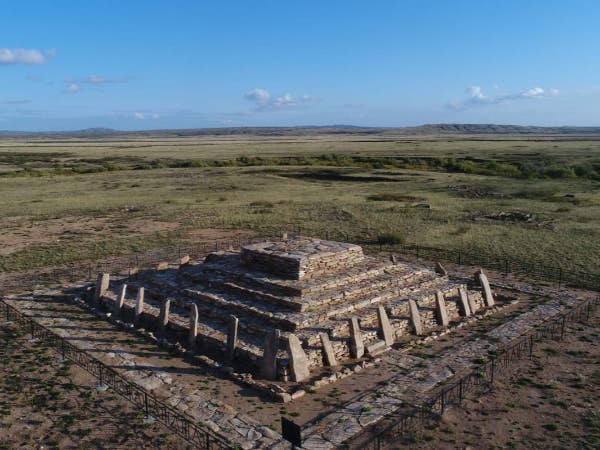Scientists unearth 3,000 year old pyramid hidden in Central Asia
A hidden pyramid structure dating back more than 3,000 years has been discovered in the vast steppes of Central Asia.

The burial ground contains 32 structures that are monuments of the Begazy-Dandybai culture. (CREDIT: CC BY-SA 3.0)
A significant archaeological discovery has emerged from the steppes of Central Asia—a pyramid structure over 3,000 years old. Named the "Pyramid of Karazhartas," this monument was found along the Taldy River in the Karaganda region of central Kazakhstan.
Built by the Begazy-Dandibay culture, this pyramid offers insights into a thriving civilization from the Late Bronze Age.
The Begazy-Dandibay Culture
The Begazy-Dandibay culture thrived in central Kazakhstan during the Late Bronze Age. This society was semi-sedentary, focusing mainly on metallurgy and animal husbandry. The communities prospered economically by trading metals across Eurasia, which led to the rise of a new aristocratic class within their culture.
Historian Serhan Cinar and archaeologist Aybar Kasenali, coordinators of the excavation project with the Kazakh National Museum, assert that the Pyramid of Karazhartas served as a mausoleum for a member of this aristocratic class. This pyramidal tomb stands as one of the most remarkable monuments of the Begazy-Dandibay culture.
The Karazhartas Pyramid
The Sary Arka Archaeological Expedition of Karaganda University, responsible for these groundbreaking excavations, has revealed the Pyramid of Karazhartas to be a square pyramidal mausoleum with distinctive step-like layers. This grand structure measures approximately 65 feet by 98 feet and rises to a height of about 5 feet at its apex. Notably, the Pyramid of Karazhartas represents the largest burial structure ever found belonging to the Begazy-Dandibay elite.
Related Stories
Cinar points out that the construction of such a colossal pyramid during the Bronze Age, especially in the arid steppe region, reflects the advanced artistic and spiritual achievements of the Begazy-Dandibay society. The pyramid's intricate construction and use of cut stones demonstrate a rich cultural heritage.
Discoveries within the Pyramid
Archaeologists exploring the interior of the Karazhartas pyramid have made several intriguing discoveries. At the heart of the mausoleum lies a sarcophagus structure, surrounded by granite stones. Inside the sarcophagus, researchers unearthed the skull of a local ruler, providing a fascinating glimpse into the identity of the individual interred within.
In one section of the upper burial chamber, archaeologists came across a bronze arrowhead and a mysterious pottery fragment. Additionally, animal bones were found scattered throughout the burial chamber and the step-like layers of the pyramid, suggesting their use in traditional steppe tribal ceremonies. These artifacts affirm the high social status of the individual buried here.
To determine the age of the Pyramid of Karazhartas, scientists from Queen's University in the United Kingdom conducted a detailed analysis of organic materials found at the site. The results of their research indicate that the pyramid dates back to the 15th-14th centuries B.C., firmly situating it within the Late Bronze Age.
The Kent Proto-City Settlement
Beyond the pyramid's impressive stature, the archaeological team uncovered evidence of a proto-city settlement named Kent in close proximity to the mausoleum. This settlement, sprawling across an area of 15 hectares, presents a fascinating window into the urbanization of the Begazy-Dandibay culture.
Kent was characterized by labyrinthine gates, ditches, and protective walls, underscoring a well-planned urban layout. The settlement boasted an organized street network and efficient water collection systems, indicative of an advanced society. Adjacent to Kent, archaeologists stumbled upon special sacrificial altars used for making ceremonial offerings to the gods.
Religious Practices of the Begazy-Dandibay Culture
Intriguingly, Cinar explains that the rituals of the Bronze Age inhabitants of Kazakhstan involved offerings to celestial bodies like the sun and the moon, as well as to fire and protective "ongun" spirits. These religious practices shed light on the spiritual beliefs and cultural traditions of the Begazy-Dandibay culture.
The discoveries at the Pyramid of Karazhartas offer a wealth of information about the historical identity, cultural connections, and socioeconomic structure of the Begazy-Dandibay culture. This enigmatic society, once hidden beneath the sands of time, is now emerging as a pivotal civilization in Central Asia's ancient history.
The Pyramid of Karazhartas stands as a testament to the remarkable achievements of the Begazy-Dandibay culture, revealing their sophisticated burial practices and urbanization. This archaeological find has not only unlocked the secrets of an ancient civilization but has also added a new chapter to the rich tapestry of Central Asia's past.
As researchers continue to delve deeper into the mysteries of this ancient culture, we can anticipate further revelations that will illuminate the history of this fascinating region.
Note: Materials provided above by The Brighter Side of News. Content may be edited for style and length.
Like these kind of feel good stories? Get The Brighter Side of News' newsletter.
Joseph Shavit
Head Science News Writer | Communicating Innovation & Discovery
Based in Los Angeles, Joseph Shavit is an accomplished science journalist, head science news writer and co-founder at The Brighter Side of News, where he translates cutting-edge discoveries into compelling stories for a broad audience. With a strong background spanning science, business, product management, media leadership, and entrepreneurship, Joseph brings a unique perspective to science communication. His expertise allows him to uncover the intersection of technological advancements and market potential, shedding light on how groundbreaking research evolves into transformative products and industries.



